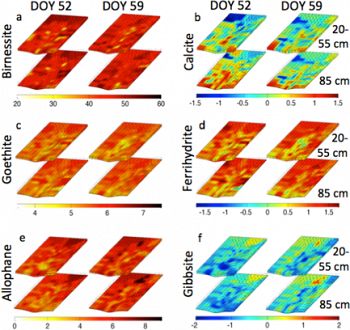Pohlmann et al., 2016
Pore water chemistry reveals gradients in mineral transformation across a model basaltic hillslope
Pohlmann M., Dontsova K., Root R., Ruiz J., Troch P., and Chorover J. (2016)
Geochemistry, Geophysics, Geosystems 17(6): 2054–2069
-
Catalina-Jemez, GRAD STUDENT
-
Catalina-Jemez, INVESTIGATOR
-
Catalina-Jemez, INVESTIGATOR
Abstract
Three-dimensional interpolations of saturation index rendered onto the hillslope schematic at two depth intervals (20–55 cm and ≥85 cm) and two sampling dates (DOY 52 and DOY 59) for six secondary minerals. Warm colors (dark in BW) represent areas of supersaturation while cool colors (light in BW) represent areas of reduced supersaturation or undersaturation. Note each mineral type has a unique scale for saturation index (i.e., log Q/K).
The extent of weathering incongruency during soil formation from rock controls local carbon and nutrient cycling in ecosystems, as well as the evolution of hydrologic flow paths. Prior studies of basalt weathering, including those that have quantified the dynamics of well-mixed, bench-scale laboratory reactors or characterized the structure and integrated response of field systems, indicate a strong influence of system scale on weathering rate and trajectory. For example, integrated catchment response tends to produce lower weathering rates than do well mixed reactors, but the mechanisms underlying these disparities remain unclear. Here we present pore water geochemistry and physical sensor data gathered during two controlled rainfall-runoff events on a large-scale convergent model hillslope mantled with 1 m uniform depth of granular basaltic porous media. The dense sampler and sensor array (1488 samplers and sensors embedded in 330 m3 of basalt) showed that rainfall-induced dissolution of basaltic glass produced supersaturation of pore waters with respect to multiple secondary solids including allophane, gibbsite, ferrihydrite, birnessite and calcite. The spatial distribution of saturation state was heterogeneous, suggesting an accumulation of solutes leading to precipitation of secondary solids along hydrologic flow paths. Rapid dissolution of primary silicates was widespread throughout the entire hillslope, irrespective of up-gradient flowpath length. However, coherent spatial variations in solution chemistry and saturation indices were observed in depth profiles and between distinct topographic regions of the hillslope. Colloids (110–2000 nm) enriched in iron (Fe), aluminum (Al), and phosphorus (P) were mobile in soil pore waters.
Citation
Pohlmann M., Dontsova K., Root R., Ruiz J., Troch P., and Chorover J. (2016): Pore water chemistry reveals gradients in mineral transformation across a model basaltic hillslope. Geochemistry, Geophysics, Geosystems 17(6): 2054–2069. DOI: 10.1002/2016GC006270
Explore Further




